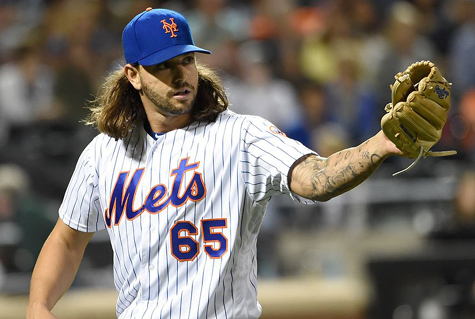
The Mets currently have seven above-average starting pitchers. One of them was for many years a highly-touted prospect who the Mets received in a trade that sent Carlos Beltran to the San Fransisco Giants. Zack Wheeler, 26, pitched well in 2013 and 2014 before going under the knife to repair a torn UCL in his pitching elbow. He is finally ready to return to the mound, but there might be someone standing in his way.
Because of injuries to the starting rotation in 2016, Robert Gsellman was called up to the Show and impressed just about everyone. Despite having posted a 3.99 ERA and striking out 88 batters in 115 minor league innings before his promotion, Gsellman put those numbers behind him and went 4-2 with a 2.42 ERA, 2.63 FIP, and 42 strikeouts in 44 Major League innings.
One of the reasons that might have contributed to his success was the sudden uptick in velocity upon his arrival in New York, as he averaged 93.7 mph on his fastball, often hitting 94-96 mph. He also benefitted from having Dan Warthen as his pitching coach, as he picked up the “Warthen Slider” fairly quickly.
As Zack Wheeler is preparing to return to the mound for the Mets, there is a general thought that he will begin the season in the bullpen and Gsellman will be the 5th man in the rotation behind Noah Syndergaard, Jacob deGrom, Matt Harvey, and Steven Matz. Many say it is to save Wheeler innings, or maybe even because Wheeler would thrive in the bullpen. However, many people aren’t considering the reason that the 23 year-old Gsellman might just be a better pitcher.
The fun part about this conversation is that it is not comparing apples to oranges. These two pitchers are very similar in that their repertoire is almost identical. While Wheeler throws slightly harder, averaging 94.5 mph on his fastball compared to Gsellman’s 93.7, he can dial it up to 98 if need be, something that Gsellman has not yet shown he can do. Besides that, though, the rest is eerily similar.
Each of their second best pitches are their slider, again most likely due to Dan Warthen. Wheeler’s averages at 88.2 mph while Gsellman’s sits at 87.9, but Gsellman’s has been more effective as batters have hit .179 against it compared to .234 against Wheeler’s. Then comes the curveballs, a pitch that averages 81.2 mph out of Gsellman’s hand and 78.4 mph out of Wheeler’s. Batters have hit .125 against Gsellman’s deuce and .185 off of Wheeler’s Uncle Charlie.
Granted, Gsellman’s sample size (44.2 innings) is much smaller than Wheeler’s (285.1 innings). Batters have hit .275 against Gsellman’s fastball, of which he has thrown 451, while Wheeler has thrown 3426 off which batters have only managed a .213 BAA. Gsellman has thrown 145 sliders and 76 curveballs while Wheeler has thrown 757 sliders and 680 curves.

Because of the sample size gap, we should look at some more qualitative numbers than pitch counts, strikeouts, etc. Since Gsellman’s debut, he has started seven games (and appeared in relief in one), posting a 2.63 FIP, 1.276 WHIP, and 1.5 WAR. In Wheeler’s 49 starts in 2012-13, he posted a 3.77 FIP, 1.339 WHIP, and 2.0 WAR. They have identical 8.5 SO/9 ratios, but Wheeler’s problem has been command as his career BB/9 is 3.9 compared to Gsellman’s 3.0.
In this scenario, we are looking at two pitchers with very similar repertoires. One has pitched a lot less but a lot better, while the other has pitched a lot more but not quite as well. If the decision were based on the sheer volume of their hair, Gsellman would be a lock as the better pitcher, but it’s not that easy. Both are young, talented pitchers, hopefully with long careers ahead of them. Gsellman might end up in the rotation for now to save Wheeler innings in the beginning of the season, but don’t be surprised if he stays there the whole season and wins the NL Rookie of the Year award.
















